




Barrel Cactus Cholla Cactus Pincushion Cactus Mystery Cactus
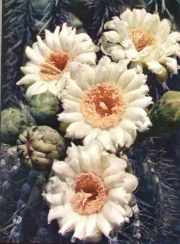
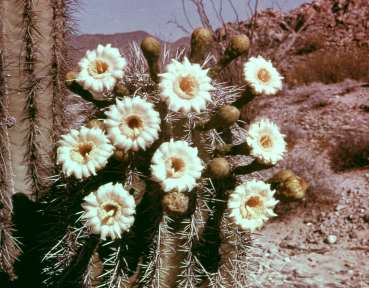 The
Saguaro Carnegiea gigantea is not the largest of cacti even though it
is called the giant cactus. It has white, waxy flowers that are held like delicate
garlands on long, outstretched, and often contorted limbs, flowers unsurpassed
for exquisiteness of design. It’s natural habitat is southern Arizona. It has
a strong supporting cylindrical core of rods extending to its full height, joined
by succulent tissue on the inside as well as outside. Their sculpturesque forms
tower from 40 to 50 feet. The rods support the tremendous weight of the plant
throughout its life, a worthy feat considering that an adult saguaro will weight
as much as 10 to 15 tons. The spines of the plant are of two kinds. For its
first 50 to 60 years it bears heavy, reddish-brown spines that eventually weather
to a dull black. On reaching flowering age, or maturity, the new spines are
more flexible yellow needlelike bristles, densely felted at the base.
The
Saguaro Carnegiea gigantea is not the largest of cacti even though it
is called the giant cactus. It has white, waxy flowers that are held like delicate
garlands on long, outstretched, and often contorted limbs, flowers unsurpassed
for exquisiteness of design. It’s natural habitat is southern Arizona. It has
a strong supporting cylindrical core of rods extending to its full height, joined
by succulent tissue on the inside as well as outside. Their sculpturesque forms
tower from 40 to 50 feet. The rods support the tremendous weight of the plant
throughout its life, a worthy feat considering that an adult saguaro will weight
as much as 10 to 15 tons. The spines of the plant are of two kinds. For its
first 50 to 60 years it bears heavy, reddish-brown spines that eventually weather
to a dull black. On reaching flowering age, or maturity, the new spines are
more flexible yellow needlelike bristles, densely felted at the base.
Below are some pictures taken by Paige, they are of a twenty plus foot saguaro in a yard in Phoenix. It fell over, because of an unusual amount of rain. It had a base "trunk" and two "bunny" ears fall off the top. With the weight of the water, it just got too heavy and fell. It does have black like mold inside of the joint, possibly from the over abundance of rain. Thanks Paige for allowing us to share your pictures, unfortunately it did not recover.
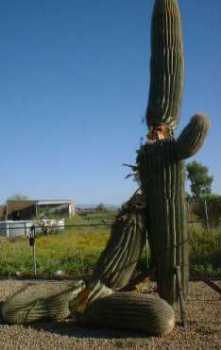
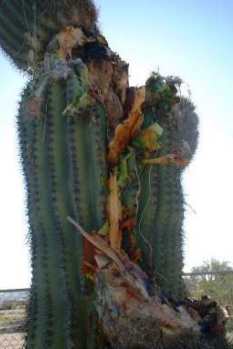
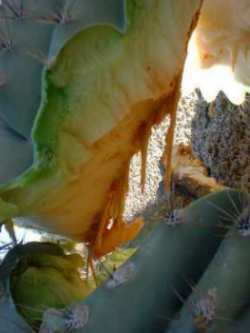
Saguaro Cactus Cholla Cactus Pincushion Cactus Mystery Cactus
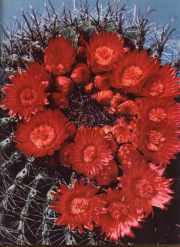 At
right the Arizona Barrel Ferocactus Wislizenii. The barrel cactus is
well suited for life in the desert, the woody core of the stem is 1 to 3 inches
in diameter. The swollen cortex surrounding it may be several inches thick.
It has a tough parchment like epidermis of strong ribbed stem and is heavily
waxed to prevent the escape of moisture. Brightly colored spines further decrease
evaporation by cutting off 20 per cent of the sunlight and raising the humidity
in the shaded area between the spines. Young plants are spherical while more
mature plants are cylindrical, growing as high as 8 feet and up to 2 feet in
diameter. Some of the flowers on a barrel cactus are 3 inches across and range
in colors from yellow to dark red. They have a crown of flowers worn to give
a regal look. They generally bloom in July through September. Most barrel cactus
lean toward the southwest and therein they have earned the common name of compass
cactus. During a good rainy season a barrel cactus can absorb and store enough
water to last during years of drought. The growth of barrel cactus is very slow.
At
right the Arizona Barrel Ferocactus Wislizenii. The barrel cactus is
well suited for life in the desert, the woody core of the stem is 1 to 3 inches
in diameter. The swollen cortex surrounding it may be several inches thick.
It has a tough parchment like epidermis of strong ribbed stem and is heavily
waxed to prevent the escape of moisture. Brightly colored spines further decrease
evaporation by cutting off 20 per cent of the sunlight and raising the humidity
in the shaded area between the spines. Young plants are spherical while more
mature plants are cylindrical, growing as high as 8 feet and up to 2 feet in
diameter. Some of the flowers on a barrel cactus are 3 inches across and range
in colors from yellow to dark red. They have a crown of flowers worn to give
a regal look. They generally bloom in July through September. Most barrel cactus
lean toward the southwest and therein they have earned the common name of compass
cactus. During a good rainy season a barrel cactus can absorb and store enough
water to last during years of drought. The growth of barrel cactus is very slow.
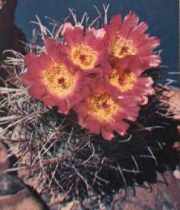 At
left the Little Barrel Sclerocactus Whipplei.
At
left the Little Barrel Sclerocactus Whipplei.
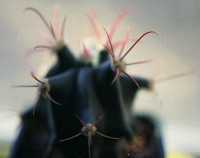 This
Coville's Barrel Ferocactus Covillei is native to the Sonora Desert and
south western Arizona. It has a hooked central spine and straight radial spines
on the areole, which is fuzzy. They have habit of leaning toward the southwest
and that has earned them another common name of compass cactus. They also have
a tough parchment like epidermis of strongly ribbed stem and is heavily waxed
to prevent the escape of moisture. They are slow growing as are all barrel cactus
and as elongated youth they can be mistaken for Saguaros.
This
Coville's Barrel Ferocactus Covillei is native to the Sonora Desert and
south western Arizona. It has a hooked central spine and straight radial spines
on the areole, which is fuzzy. They have habit of leaning toward the southwest
and that has earned them another common name of compass cactus. They also have
a tough parchment like epidermis of strongly ribbed stem and is heavily waxed
to prevent the escape of moisture. They are slow growing as are all barrel cactus
and as elongated youth they can be mistaken for Saguaros.
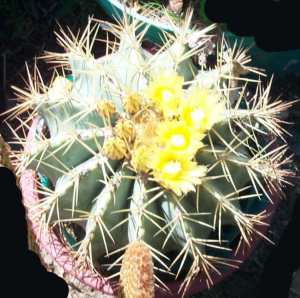
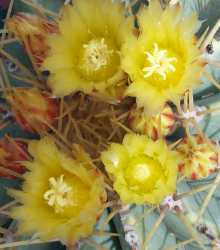 This
Arizona barrel Ferocactus Wislizenii is blooming after four days of 100+
temperature and it's only May. The habit of a leaning toward the sun is believed
to be caused by the more rapid evaporation on the side facing the sun, bringing
about a state of "incipient drying" in the walls of the cell tissues. Cell growth
is retarded as it loses water faster than it can absorb the water. This one
is in a pot and gets moved around now, it will soon be in the ground and will probably lean as time goes on.
This
Arizona barrel Ferocactus Wislizenii is blooming after four days of 100+
temperature and it's only May. The habit of a leaning toward the sun is believed
to be caused by the more rapid evaporation on the side facing the sun, bringing
about a state of "incipient drying" in the walls of the cell tissues. Cell growth
is retarded as it loses water faster than it can absorb the water. This one
is in a pot and gets moved around now, it will soon be in the ground and will probably lean as time goes on.
 This new pup came from a barrel that is about 2 foot across and has beautiful
red flowers. It's well adjusted to our weather as the mom has grown up here
in the mountain area for almost 15 years. Received 3 pups so will be nice to
see it grow in our garden, although this one is now inside in a pot. More pictures
as it progresses.
This new pup came from a barrel that is about 2 foot across and has beautiful
red flowers. It's well adjusted to our weather as the mom has grown up here
in the mountain area for almost 15 years. Received 3 pups so will be nice to
see it grow in our garden, although this one is now inside in a pot. More pictures
as it progresses.
Barrel Cactus Saguaro Cactus Pincushion Cactus Mystery Cactus
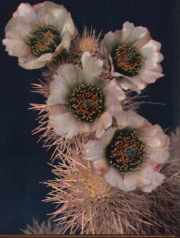 The
Cholla cactus, it is pronounced "choya" and is a Spanish word meaning
head-shaped. It is a distinguished by cylindrical joints and often the branches
and joints are shaped in the form of a human head, thus the name. At right is
a jumping Cholla Opuntia Bigelovii it is the most dangerous cactus that
man or animal can encounter in the desert. The jumping Cholla spines will penetrate
the toughest hide at the least touch. The Kangaroo rat uses the fallen joints
to build his home, sometimes piling the mounds of debris 3 to 4 feet high and
7 to 8 feet across. How the kangaroo rat accomplishes this is one of the mysteries
of the desert. A jumping Cholla’s habit of dropping its joints, seem to have
as its objective the conservation of moisture and the desire to reproduce vegetatively.
These flowers are nearly the same in color whitish with green centers. The spine
cluster is three pronged and barbed. Its flowers often remain unopened on the
plant for years, with the newer flowers being the largest ones. They seldom
have a chance to germinate. The plants can grow as high as 12 feet.
The
Cholla cactus, it is pronounced "choya" and is a Spanish word meaning
head-shaped. It is a distinguished by cylindrical joints and often the branches
and joints are shaped in the form of a human head, thus the name. At right is
a jumping Cholla Opuntia Bigelovii it is the most dangerous cactus that
man or animal can encounter in the desert. The jumping Cholla spines will penetrate
the toughest hide at the least touch. The Kangaroo rat uses the fallen joints
to build his home, sometimes piling the mounds of debris 3 to 4 feet high and
7 to 8 feet across. How the kangaroo rat accomplishes this is one of the mysteries
of the desert. A jumping Cholla’s habit of dropping its joints, seem to have
as its objective the conservation of moisture and the desire to reproduce vegetatively.
These flowers are nearly the same in color whitish with green centers. The spine
cluster is three pronged and barbed. Its flowers often remain unopened on the
plant for years, with the newer flowers being the largest ones. They seldom
have a chance to germinate. The plants can grow as high as 12 feet.
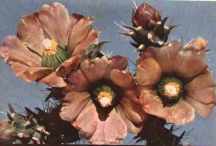 At
left is the Cane Cholla Opuntia Spinosior .These cactus are openly branched
with distinct treelike appearance, and grow as tall as 10 feet.
At
left is the Cane Cholla Opuntia Spinosior .These cactus are openly branched
with distinct treelike appearance, and grow as tall as 10 feet.
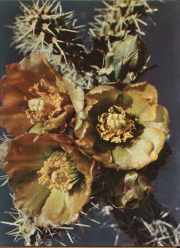 Other
members of this family are the Staghorn Cholla Opuntia Versicolor. They
are more intricately branched, forming denser crowns, and bearing green and
purplish fruit. They come in a variety of colors from the palest yellow to green
to the deepest reds. There finely barbed spines are uneven in length, ranging
from ¼ to 1 inch in length. The lacy wood inner core, or woody skeleton is used
by craftsmen for furniture, novelties and picture frames. I use them in macramé
projects. The fruit is used in fixing a dye known in native arts as cochineal
dye. They bloom usually during June and July.
Other
members of this family are the Staghorn Cholla Opuntia Versicolor. They
are more intricately branched, forming denser crowns, and bearing green and
purplish fruit. They come in a variety of colors from the palest yellow to green
to the deepest reds. There finely barbed spines are uneven in length, ranging
from ¼ to 1 inch in length. The lacy wood inner core, or woody skeleton is used
by craftsmen for furniture, novelties and picture frames. I use them in macramé
projects. The fruit is used in fixing a dye known in native arts as cochineal
dye. They bloom usually during June and July.
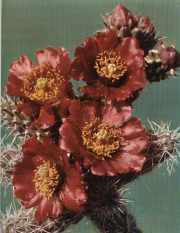 At
left is the Candelabrum Cactus Opuntia Imbricat. Its branches are arranged
in the manner of a giant, ornamental candlestick. Its specific name means overlapping,
like shingles, and refers to the overlapping tubercles that almost cover the
surface of the joints. It is tree like and grows to 3 to 8 feet tall.
At
left is the Candelabrum Cactus Opuntia Imbricat. Its branches are arranged
in the manner of a giant, ornamental candlestick. Its specific name means overlapping,
like shingles, and refers to the overlapping tubercles that almost cover the
surface of the joints. It is tree like and grows to 3 to 8 feet tall.

This Cholla is a new one just added to our collection in the spring of 1999, as a purchase from the Fresno Cactus and Succulent Association's spring show and plant swap. I forgot to get the names of my new cacti.
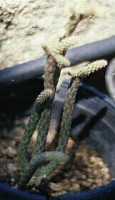 Another
mystery Cholla cactus it is an Opuntia can't be more "specific" this
one has fuzzy spines that will get all over you and it also is a new one, I
received it at a show in Fresno, CA!!
Another
mystery Cholla cactus it is an Opuntia can't be more "specific" this
one has fuzzy spines that will get all over you and it also is a new one, I
received it at a show in Fresno, CA!!
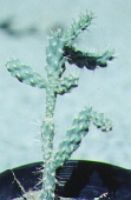 This
is a mystery cactus is an Opuntia, can't be more "specific" it has been
in my garden for a long time and grows very slowly there.
This
is a mystery cactus is an Opuntia, can't be more "specific" it has been
in my garden for a long time and grows very slowly there.
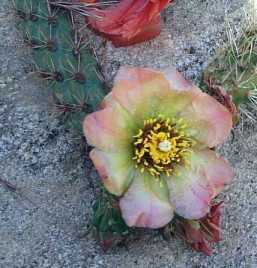
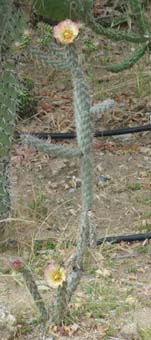 This appears to be a cane cholla cactus Optunia spinosior, they are noted
for their grotesque shapes and exquisitely colored flowers, This one blends
from cream to pink.
This appears to be a cane cholla cactus Optunia spinosior, they are noted
for their grotesque shapes and exquisitely colored flowers, This one blends
from cream to pink.
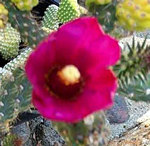
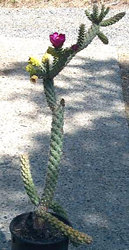 This cane or cholla was a gift that continues to show off more and more, it
came without a name or any other information and has been a welcome addition
to our collection.
This cane or cholla was a gift that continues to show off more and more, it
came without a name or any other information and has been a welcome addition
to our collection.
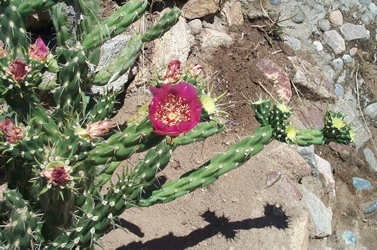 This
cane cholla Opuntia spinosior is tree like in form the flowers bloom
early here in May and June. It's lacy, wooden skeleton, like that of other cholla
is used in the manufacturing of novelty furniture and picture frames, we use
it in making macramé projects. It has fruit from both this year and last
year on it.
This
cane cholla Opuntia spinosior is tree like in form the flowers bloom
early here in May and June. It's lacy, wooden skeleton, like that of other cholla
is used in the manufacturing of novelty furniture and picture frames, we use
it in making macramé projects. It has fruit from both this year and last
year on it.

 Have
had this cane for 20 years, this is the first time it has ever bloomed.
Have
had this cane for 20 years, this is the first time it has ever bloomed.
Barrel Cactus Saguaro Cactus Cholla Cactus Mystery Cactus
Should
a cactus fancier grow only Mammillarias, he would have a never-ending
source of variety and interest. They constitute a large genus of cacti, more
than 150 species, with enormous differences in spines, color and growth habit.
Some have a single rounded stem, others form large clusters; the stems may be
covered with long white hairs, soft or stiff spines, even hooks. What is common
to all Mammillarias is that they have no ribs but bear protuberances
on the stems with spines on their tips. Flowers, produced in spring and summer,
usually form garlands around the tops of the stems. White, yellow, pink and
magenta are the commonest colors. Flowers are followed by shiny red fruit that
may remain on the plants for many months. Most Mammillarias flower when
they are young; seed-grown plants blossom in four to five years. As windowsill
plants, most are ornamental even when they are not in flower, are easy to grow
and remain small.
 This
is the Snowball Cactus Mammillaria Oliviae, it is a type of Pincushion
Cactus, which is any small globular or cylindrical cactus having numerous pin
like spines. Those with hooks at the ends are also called "fishhook cacti."
They are numerous and so distantly related that they have been divided into
several groups the largest group is the genus Mammillaria. The snowball
pincushion is one of the gems of this group. It has blue-green, flat-topped
spherical stems about 3 inches thick, which are covered with tiny white spines.
Pink flowers 3/4 inch long appear in early summer.
This
is the Snowball Cactus Mammillaria Oliviae, it is a type of Pincushion
Cactus, which is any small globular or cylindrical cactus having numerous pin
like spines. Those with hooks at the ends are also called "fishhook cacti."
They are numerous and so distantly related that they have been divided into
several groups the largest group is the genus Mammillaria. The snowball
pincushion is one of the gems of this group. It has blue-green, flat-topped
spherical stems about 3 inches thick, which are covered with tiny white spines.
Pink flowers 3/4 inch long appear in early summer.
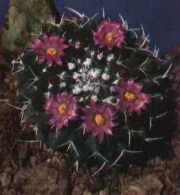 This
is the Mexican Pincushion Mammillaria Magnimamma
This
is the Mexican Pincushion Mammillaria Magnimamma
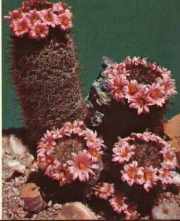 This
is Miller’s Pincushion Mammillaria Microcarpa var. Milleria
This
is Miller’s Pincushion Mammillaria Microcarpa var. Milleria
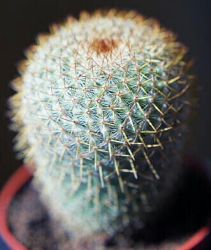
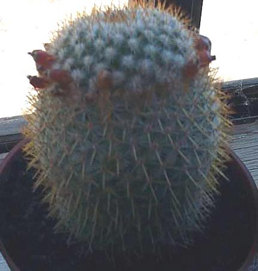
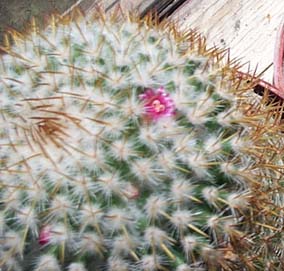 Pincushion
Cactus Mammillaria Scheidweilerana has deep pink flowers that will set
with seed pods. As shown in the photo at the left. The flowers are set deep
in between the spines as shown in the middle. The seed pods are very long when
taken from this plant.
Pincushion
Cactus Mammillaria Scheidweilerana has deep pink flowers that will set
with seed pods. As shown in the photo at the left. The flowers are set deep
in between the spines as shown in the middle. The seed pods are very long when
taken from this plant.
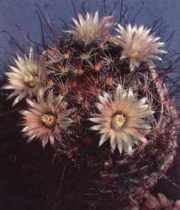 At
right is the Pinal Pincushion Mammillaria Wilcoxii
At
right is the Pinal Pincushion Mammillaria Wilcoxii
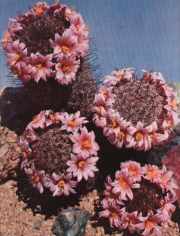 Fishhook
Cactus Mammillaria Microcarpa has little candy striped flowers of lavender,
red or pink that form a circle near the top of the stems in April and then again
in August. They can bloom anytime between February to October. The cylindrical
stems are about 4 inches high and are studded with nipple like tubercles. At
the tips of the tubercles are spines that radiate like spokes in a wheel, but
sometimes form star like clusters. The plants sometimes consist of three or
more stems, but generally are only one.
Fishhook
Cactus Mammillaria Microcarpa has little candy striped flowers of lavender,
red or pink that form a circle near the top of the stems in April and then again
in August. They can bloom anytime between February to October. The cylindrical
stems are about 4 inches high and are studded with nipple like tubercles. At
the tips of the tubercles are spines that radiate like spokes in a wheel, but
sometimes form star like clusters. The plants sometimes consist of three or
more stems, but generally are only one.
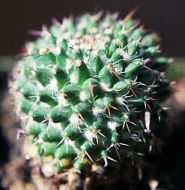
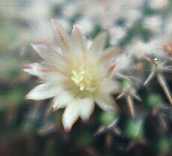 This
cactus is new to our collection it is a Mammillaria bravoe cactus. It
will be interesting to see the flowers on this cactus. It has decided to bloom
in October and November with tiny little cream colored flowers. This has been
a very nice surprise.
This
cactus is new to our collection it is a Mammillaria bravoe cactus. It
will be interesting to see the flowers on this cactus. It has decided to bloom
in October and November with tiny little cream colored flowers. This has been
a very nice surprise.
 This is new one to our collection it is Mammilaria Gracilis.
This is new one to our collection it is Mammilaria Gracilis.
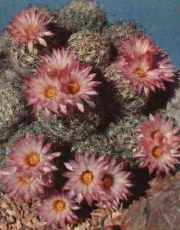 This
is the Common Pincushion Coryphantha vivpara var. aggreata or "Rising
Biscuits". The Coryphantha are top-flowering and are referred to
as "Rising Biscuits" usually flatten out in winter from dehydration, but after
a rain they swell and rise into mounds of small globes. They are globular and
studded with tubercles spirally arranged. Each cluster of thirty to forty needlelike
spines that completely hide the plant body. They have pink to lavender flowers
in late May and June.
This
is the Common Pincushion Coryphantha vivpara var. aggreata or "Rising
Biscuits". The Coryphantha are top-flowering and are referred to
as "Rising Biscuits" usually flatten out in winter from dehydration, but after
a rain they swell and rise into mounds of small globes. They are globular and
studded with tubercles spirally arranged. Each cluster of thirty to forty needlelike
spines that completely hide the plant body. They have pink to lavender flowers
in late May and June.
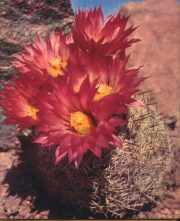 This
is the Arizona Pincushion Cactus Coryphantha vivpara var. Arizonica.
They generally bloom during June. This small-growing species is widely distributed
throughout the central United States. The northern forms of this plant are winter
hardy, even into Canada. It requires good light and regular watering during
summer with a dry, cold winter rest period. It bears fringed, fragrant flowers
in midsummer.
This
is the Arizona Pincushion Cactus Coryphantha vivpara var. Arizonica.
They generally bloom during June. This small-growing species is widely distributed
throughout the central United States. The northern forms of this plant are winter
hardy, even into Canada. It requires good light and regular watering during
summer with a dry, cold winter rest period. It bears fringed, fragrant flowers
in midsummer.
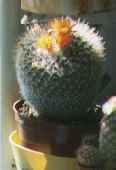 A
Yellow Pincushion cactus Notocactus haselbergii is a cylindrical cactus
and has numerous pin like spines. They are a compact, white-spined species requiring
a sunny location and average soil with moderate watering in summer this one
has more yellow flowers than is normal. This plant needs a long, dry winter
rest to ensure flowering, but like slight warmth. All Notocactus are good houseplants,
flowering readily without elaborate care.
A
Yellow Pincushion cactus Notocactus haselbergii is a cylindrical cactus
and has numerous pin like spines. They are a compact, white-spined species requiring
a sunny location and average soil with moderate watering in summer this one
has more yellow flowers than is normal. This plant needs a long, dry winter
rest to ensure flowering, but like slight warmth. All Notocactus are good houseplants,
flowering readily without elaborate care.
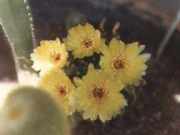 This
Pincushion Notocactus is a beauty that grows in pots outside, inside,
and in our garden it's beautiful yellow flowers last days. It is some kind of
pincushion, it genus is, I'm told, Notocactus. It has a crown of flowers.
It has a central spine circled by tubercles, the radial spines are all connected
to the areole, and completely hide the plant. Pincushion cacti live up to their
name when they are young, forming clumps of handsome globular plants 1 1/2 to
2 1/2 inches across. As they become older, however, they stretch upward, becoming
cylindrical in shape. All are easy to grow on a window sill. This one has yellow
flowers.
This
Pincushion Notocactus is a beauty that grows in pots outside, inside,
and in our garden it's beautiful yellow flowers last days. It is some kind of
pincushion, it genus is, I'm told, Notocactus. It has a crown of flowers.
It has a central spine circled by tubercles, the radial spines are all connected
to the areole, and completely hide the plant. Pincushion cacti live up to their
name when they are young, forming clumps of handsome globular plants 1 1/2 to
2 1/2 inches across. As they become older, however, they stretch upward, becoming
cylindrical in shape. All are easy to grow on a window sill. This one has yellow
flowers.
 This
is a Lemon Donut Notocactus Graessneri it only grows to a height of 4"
and has 3/4" long yellow-green flowers in the spring. It likes fresh air,
filtered or direct sunlight and to be drenched thoroughly when dry. It's spines
are red in color and some are as long as one half inch. The flower are on the
top of this night blooming cactus.
This
is a Lemon Donut Notocactus Graessneri it only grows to a height of 4"
and has 3/4" long yellow-green flowers in the spring. It likes fresh air,
filtered or direct sunlight and to be drenched thoroughly when dry. It's spines
are red in color and some are as long as one half inch. The flower are on the
top of this night blooming cactus.

 The
Sun cup Notocactus Apricus likes fresh air, direct sunlight and is easy
to grow. It likes to be drenched thoroughly when dry and produces beautiful
yellow flowers whose center is unique. It's central spine is red surrounded
by white straight spines. The top of this one is now loaded with buds and flowers
that are slowly blooming, three blooms at a time. There is also a baby sneaking
out at the base.
The
Sun cup Notocactus Apricus likes fresh air, direct sunlight and is easy
to grow. It likes to be drenched thoroughly when dry and produces beautiful
yellow flowers whose center is unique. It's central spine is red surrounded
by white straight spines. The top of this one is now loaded with buds and flowers
that are slowly blooming, three blooms at a time. There is also a baby sneaking
out at the base.
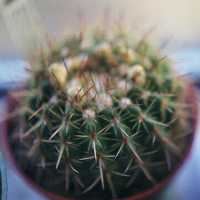 This
Ball Cactus Notocactus roseoluteus likes full sun and is easy to grow.
Allow the soil to dry out between watering, and it enjoys cool temperature of
between 45 - 65 F. It is suggested that watering be done every two weeks, and
this would depend on the humidity where it is grown. We've waited to add the
picture when it blooms, and hope that will be soon. It appeared ready to bloom
and we are still waiting. Other pictures are not worth posting.
This
Ball Cactus Notocactus roseoluteus likes full sun and is easy to grow.
Allow the soil to dry out between watering, and it enjoys cool temperature of
between 45 - 65 F. It is suggested that watering be done every two weeks, and
this would depend on the humidity where it is grown. We've waited to add the
picture when it blooms, and hope that will be soon. It appeared ready to bloom
and we are still waiting. Other pictures are not worth posting.
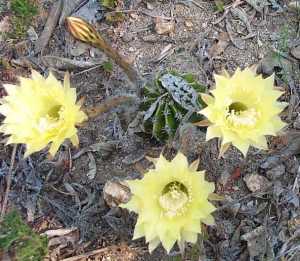 This
little plant bloomed for the first time in 2000 and has the most delicate yellow
flowers. It's the middle of May and our temperatures today are in the 100's.
It open during the night and it lasted only until noon. The bud shown in this
picture opened the following night. Such big beautiful flowers for such a small
cactus.
This
little plant bloomed for the first time in 2000 and has the most delicate yellow
flowers. It's the middle of May and our temperatures today are in the 100's.
It open during the night and it lasted only until noon. The bud shown in this
picture opened the following night. Such big beautiful flowers for such a small
cactus.
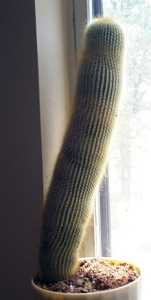
 This cactus has yellow spines and a skewed top, it could be Golden Torch Cactus
Notocactus leninghausii, it has grown to a height of at least 12 inches
tall, it has never bloomed. Just recently after many years it has begun to produce
babies. They are starting to circle the bottom of the plant. Thanks for identifying
it for me Steve. After many years in 2011 it has bloomed. It is one of the pups.
Wow it was worth the wait.
This cactus has yellow spines and a skewed top, it could be Golden Torch Cactus
Notocactus leninghausii, it has grown to a height of at least 12 inches
tall, it has never bloomed. Just recently after many years it has begun to produce
babies. They are starting to circle the bottom of the plant. Thanks for identifying
it for me Steve. After many years in 2011 it has bloomed. It is one of the pups.
Wow it was worth the wait.
Barrel Cactus Saguaro Cactus Cholla Cactus Pincushion Cactus
These are cacti we have that have no name or any other identification on them to know what they are. If we find out their names we will put that up here also.
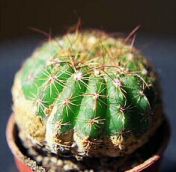 This
little mystery cactus is probably a type of pincushion, when it blooms the pictures
will be added.
This
little mystery cactus is probably a type of pincushion, when it blooms the pictures
will be added.
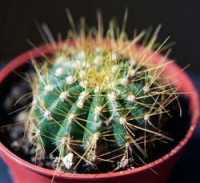 This
is also another pincushion.
This
is also another pincushion.

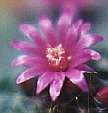 This
is a very small cactus that has been blooming in spring and summer almost continuously,
since receiving it. Although I received it in a 2" pot and it came with no name,
I moved it into a large pot. This close-up of the flower on this cactus is probably
larger than the actual flower. It is the same cactus shown at left. After blooming
almost constantly for two years, the center, larger cactus has died and the
babies are getting bigger to take it's place. We've heard that some cactus bloom
so much they wear them selves out, but this is our first experience with this
actually happening.
This
is a very small cactus that has been blooming in spring and summer almost continuously,
since receiving it. Although I received it in a 2" pot and it came with no name,
I moved it into a large pot. This close-up of the flower on this cactus is probably
larger than the actual flower. It is the same cactus shown at left. After blooming
almost constantly for two years, the center, larger cactus has died and the
babies are getting bigger to take it's place. We've heard that some cactus bloom
so much they wear them selves out, but this is our first experience with this
actually happening.
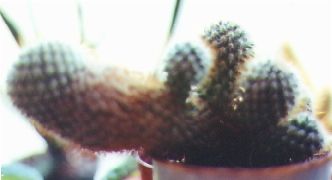 I
have no idea what this cactus is either, another mystery plant, it laid over
a few years ago and started producing babies like crazy. It's pretty mother
was about 7 inches tall when it just lay over and started baby production. It
has never bloomed.
I
have no idea what this cactus is either, another mystery plant, it laid over
a few years ago and started producing babies like crazy. It's pretty mother
was about 7 inches tall when it just lay over and started baby production. It
has never bloomed.
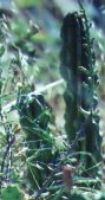 I
have no idea what this cactus is either, another mystery plant, it grows quite
tall, although this one is very young and it has never bloomed.
I
have no idea what this cactus is either, another mystery plant, it grows quite
tall, although this one is very young and it has never bloomed.
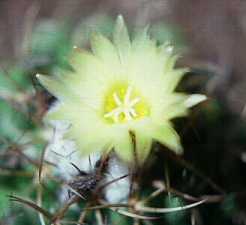 This is a ball or barrel cactus with a fuzzy white top to it. It's name I don't
know.
This is a ball or barrel cactus with a fuzzy white top to it. It's name I don't
know.
Barrel
Cactus Cholla Cactus Christmas
Cactus
Desert Cactus Cultivation
Epiphyllum Hedgehog
Cactus Hybrid Cactus
Mystery Cactus Night
Blooming Cactus Pincushion Cactus
Prickly Pear Cactus Saguaro
Cactus Succulents Sunrise Cactus
|
|
|||||
|
|
|||||
|
|
This page copyright © 1997-2011 tses
Last updated 5/25/2011
